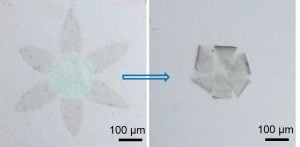
Researchers in the Department of Chemical and Biomolecular Engineering have discovered a way to fold ultrathin materials, creating three-dimensional structures with significantly altered shapes and properties. Their Oct. 6 paper in Science Advances reports the process, which involves folding up hybrid films composed of an atomically thin monolayer of graphene functionalized by thermally responsive polymer brushes. The films can be patterned into a variety of shapes including flowers and boxes, and can be selectively and reversibly folded on exposure to mild temperature increase.

Temperature induced self-folding of a functionalized graphene flower (Image: Weinan Xu/JHU)
“Folding can transform the physical and chemical properties of materials and can also be used to create 3D devices,” said David Gracias, professor. “We have achieved origami with a material that is 10,000 times thinner than a single sheet of regular paper. It opens the door to new and interesting 3D nanostructured materials and devices.”
The group demonstrated that they could use this approach to wrap a single cell with graphene, which is important for single cell biosensing, and also create creased transistor and non-linear resistive electronic devices. “This is the first time that graphene has been transformed into well-defined, mass producible 3D structures. We achieve this while preserving the excellent properties of graphene by creating an organic-inorganic hybrid ultrathin composite,” said Weinan Xu, the paper’s lead author and a post-doctoral fellow in the Gracias lab.
The experiments were rationalized using a multi-scale simulation model in collaboration with MIT researchers Zhao Qin and Chun-Teh Chen and Markus Buehler, professor. Other contributors included Johns Hopkins students Hyerin Kwag, Qinli Ma, and Anjishnu Sarkar.
(Video: Zhao Qin/MIT)